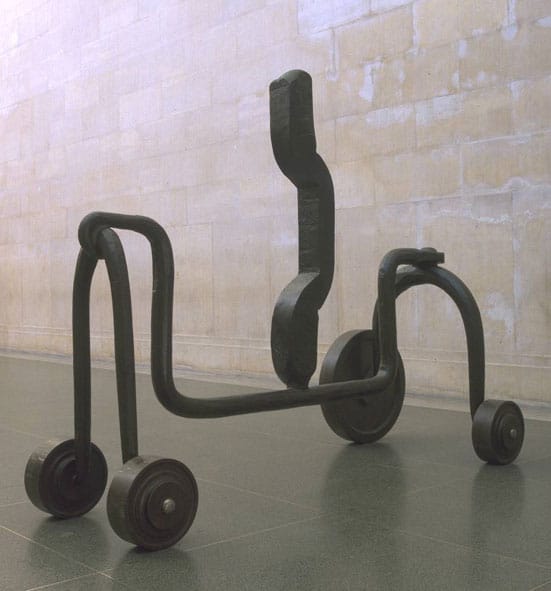1st November 2006 — 21st January 2007
Walking
into the David Smith show in the Tate Modern you first have to
navigate your way around the queues for Carsten Holler's metal
slides and the shrieks that follow those descending into the turbine
hall. These cries remain and don't get any quieter until you have
reached the third room. But it is ok, because the second room is
dedicated to Smith's 'Medals for Dishonor' and these are equally
over-dramatic and theatrical, like the rides and riders. The occasional
yelp helps as we are meant to view these wall-mounted metal reliefs
of human atrocities as his Guernica or perhaps Grosz's.
This exhibition
celebrating the centenary of Smith's birth serves to remind us
of his vital role in the changing shape of sculpture in the 20th
Century. When I fist saw the Surreal influenced busts in the first
room, such as 'Saw Head' and ' Widow's Lament,' I had an awkward
memory of Tony Hancock's 1961 film 'The Rebel.' In the film Tony
Hancock (played by Tony Hancock) creates grotesque parodies of
Picasso sculptures such as ' Aphrodite at the Waterhole" and
is seen cycling his bike over his Pollockesque splatter painting.
At this point I didn't feel that that the exhibition was really
doing a good job of reminding of the greatness of David Smith.
The 12 pieces in the third room are much more interesting as they
are viewed as a field of mainly spindly upright forms, the weight
of the work is also suddenly made apparent as is the endless brown.
Even the more delicate sculptures, with sections defined by thin
curving rods, have an underlying drag of gravity about them. There
is a vantage point in this room where you can see through into
Room 5 and the piece 'Hudson River Landscape' flattens itself out
against the white walls and looks not unlike a version of Duchamp's
'Large Glass.'
Initially I was disappointed how the rooms were
bland with white walls and unambitious lighting. They don't seem
to be making true icons of the sculptures or aiding them in their
desperate need to be outside. Ok, so there isn't a sculpture garden
at the Tate (yet, I suppose), but so many of the sculptures rely
on being in/with Nature. Smith himself talks of how he burnishes
the steel so that they can reflect the blues and greens of the
skies and the mountains and how the effect of natural light falling
on the sculptures is so important.
It is in the room with the 'Tanktotems'
and 'Sentinels', tall 'personages,' that you come across his direct
link with Abstract Expressionism. It is with the reds, greens,
and yellows that have been blotched onto pieces like '51/2' that
make them exciting. (Even though each sculpture in the room is
penned in with a wooden rail running around it.) He is often seen
as the Modernist sculptural Pollock and when Smith jokes at the
end of the exhibition that all of the 'Sentinel' pieces that surround
his house are female another likeness strikes. This machismo and
fuck and fight stance is imbued in all the works, even those pertaining
to be dealing with the psychoanalytical.
The 'Wagons' and 'Voltri'
sculptures of the 1960's make part use of scrap metal that return
to the readymade quality of the agricultural tools used in the
'Agricola' series a decade earlier. These later pieces on wheels
made me think of what John Chamberlain was to do in the decades
following with his car parts. In fact Smith starts using car spray
on these later sculptures that give a flat plain of surface colour.
When the works start to look slick, like the burnished, hollow
and shiny 'Cubi' that it becomes hard not to notice the aftermath
clots of metal where the sections have been welded together. They
need these traces of where the sculptor has been, it retains their
painterly quality - and it maintains an ongoing sense of the artist
as 'worker.'
The whole show is engrained in the past, it is art
making in a certain point of history; this way of production seems
so distant, but is only 40 years ago. By the end of the exhibition
what I really wanted to see were more of his drawings, he started
his artistic career as a painter and the drawings he made were
vital to the manifestation of the sculptures.
'I feel no tradition,
I feel great spaces.' Its funny that he should say that as now
the opposite seems truer - this exhibition is wholly lacking in
great spaces; there is tradition throughout.
BT
Tate Modern
Bankside
London SE1 9TG
http://www.tate.org.uk/modern
Open
Daily, 10am-5.50pm

David Smith
'Wagon II'
1964
Steel sculpture
Tate. Purchased with assistance from the American Fund for the Tate
Gallery, the National Art Collections Fund and the Friends of the Tate
Gallery 1999
Copyright: Estate of David Smith/ VAGA, New York, DACS 2006